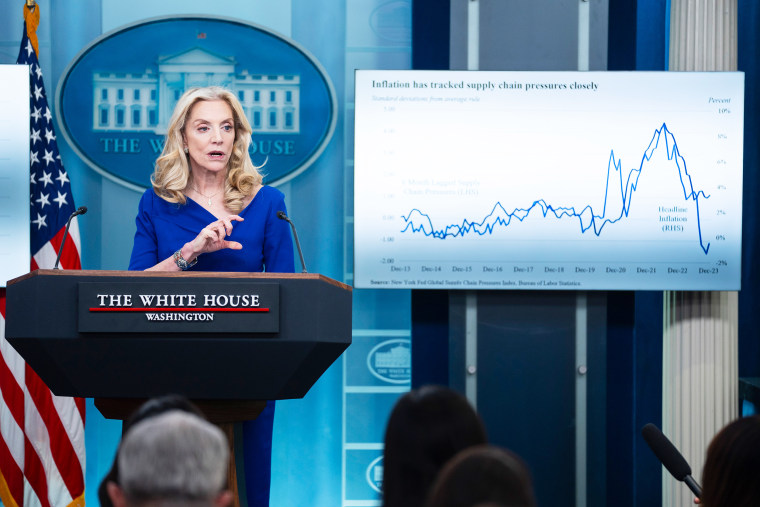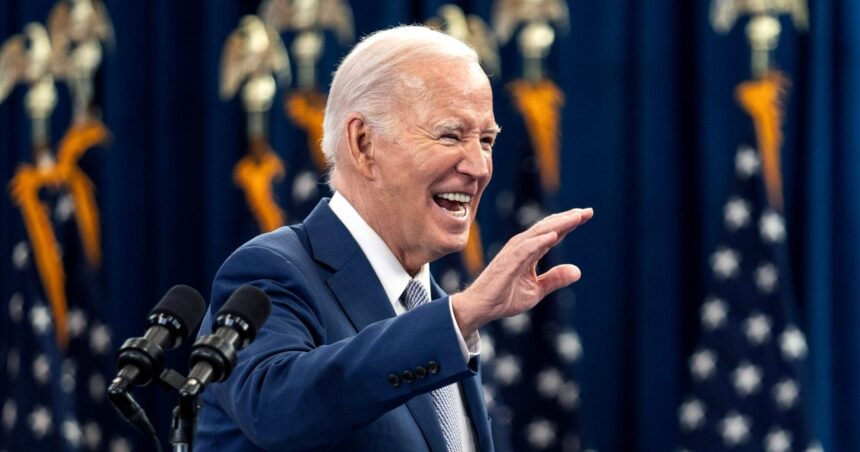After a year of catastrophic recession, a surprisingly resilient economy is boosting the White House as it accelerates the sale of its record to Americans who have just began to shed their “vibecession”.
At the same time, senior administration officials say they are increasingly convinced that the situation on the ground can largely speak for itself. The economy experienced strong growth of 3.1% pace between the fourth quarter of 2022 and the same period of last year, each inflation measurement coolsTHE the job market remains strong and the the stock market has reached record levels.
“Extraordinary” is how Lael Brainard, director of the National Economic Council, described the economy to reporters at the White House on Friday.

“We looked historically: we have never had a year where inflation declined so quickly while the economy grew above trend and unemployment remained stable at a low rate,” he said. she declared.
Jared Bernstein, chairman of the White House Council of Economic Advisers, said in an interview Friday that the economy is “a growth machine that keeps producing,” fueled by a tight labor market, robust consumer spending and rising real wages.
And in a speech Thursday to the Economic Club of Chicago, Treasury Secretary Janet Yellen boasted that the United States “is now producing far more goods and services than before the pandemic,” in the wake of ‘a recovery she described as the fairest ever recorded. .
We have never had a year where inflation declined so quickly while the economy grew above trend.
Lael Brainard, director of the National Economic Council
The dual challenge now for President Joe Biden — and the leaders of his administration and reelection campaign — is to maintain these trends while getting more Americans to notice them.
There is evidence that they already are. University of Michigan Consumer Confidence Index climbed in December and Januaryshowing the best two-month improvement since 1991. As opinions on the economy diverge along partisan lines, Democrats and Republicans posted their most favorable results in more than two years.
Some business owners who spent the last year battening down the hatches in anticipation of a recession were pleasantly surprised that it never happened.
Josh Burg, owner of a glass manufacturing company called Glass Enterprises in Bensalem, Pa., said the economy’s continued strength caught him off guard. Having prepared for a downturn last year, it ended up hiring more workers, branching out into new businesses and growing both its revenue and bottom line. He gives the current economy an A- and says he would hire even more people if he could find them.
“2023 was a good year. And I think most companies, if they engaged, would say the same thing,” he said.
But Burg didn’t completely ignore his skepticism. He still worries about high interest rates and cheap imports.
“When I evaluate candidates, I ask myself who is going to protect businesses, and for me – completely biased – who is going to protect the manufacturing industry.”
Former President Donald Trump, the big favorite for the Republican Party nomination, said Biden’s economic policy was a failure. He said earlier this month in an interview with right-wing media, “When there is an accident, I hope it will be within the next 12 months because I don’t want to be Herbert Hoover.”
A Biden campaign spokesperson called the latest economic data evidence of the “Biden agenda at work,” predicting that a second Trump administration would reverse gains for middle-class households. “We are investing early and aggressively to ensure voters understand their choice in November,” he said.
For its part, the White House plans to continue reducing uncertainty like Burg’s by highlighting portfolio victories – like reduce insulin costs for many diabetic patients and reduce direct Medicare drug prices – and pushing back overdraft and other “unwanted” chargeswith more cost-cutting efforts in the coming months.
It’s a smaller-scale policy than the historic investments in climate, infrastructure and manufacturing — some of them bipartisan — that Democrats embraced before Republicans narrowly regained the House in the mid-terms. mandate. But this is all part of the government’s plan to show that its economic program is succeeding.

Even as senior White House officials say they feel more confident making their points, they are still careful not to appear tone-deaf.
“The president and I understand that many Americans have long felt a deeper pessimism about the economy, well before the pandemic,” Yellen said Thursday, adding that “life is even harder than it needs to be.” be for the middle class in this country.”
Around Thanksgiving, the term “bidenomics” had practically disappeared of Biden’s public remarks, after an earlier attempt to pass him. At the time, some Democratic strategists and allies of the president argued that the label did not resonate with voters. Americans’ unusually poor economic outlookand Republicans were using it to blame Biden for high inflation.
The White House insists that “bidenomics” is not a buzzword. Both Biden and Yellen used the term at least once during their public appearances this week. But administration officials emphasize that they are working harder to keep trend lines rising and say the public mood will follow, reducing the need for a branding exercise.
Life is even harder than it should be for the middle class in this country.
Janet Yellen, Secretary of the Treasury
“Our work is not done,” Bernstein said, acknowledging that there are still “banana peels everywhere” to get around, geopolitical risks has a potential government shutdown. Still, he said, “if we’re on track, we should see this showing up in the sentiment indices — and lo and behold, we’re starting to see it. »
Bernstein added that he asked his team a few months ago to “think about the price level” of everyday purchases, rather than broad-based inflation statistics. “It’s the idea that people keep prices in their heads. They remember the price of eggs,” he said.
That’s certainly the case for Robert Bowden, who has worked at Glass Enterprises in Bensalem for five years. With three children aged 17, 16 and 8, he is always keenly aware that “spending is going up” on many things, even as inflation slows.
“My salary is okay… but life is getting more and more expensive,” he said.
While Trump still enjoys strong support among working-class voters, Biden officials know the work is not done in making their pitch during the roughly nine-month sprint to Election Day .
Brainard said Friday that median-income households “now have $3,500 more to spend this year after accounting for inflation.” when Biden took office. The day before in Chicago, Yellen noted that a jobs shortage that had left unemployment 20% higher in rural areas than in urban areas “had been eliminated.”
“Investments take time to bear fruit,” she said, adding: “We are investing in many things that have been ignored for decades. »




